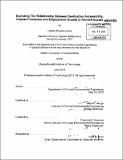| dc.contributor.advisor | Mikel E. Murga and Frederick P. Salvucci. | en_US |
| dc.contributor.author | Peralta-Quirós, Tatiana | en_US |
| dc.contributor.other | Massachusetts Institute of Technology. Department of Civil and Environmental Engineering. | en_US |
| dc.coverage.spatial | n-us-ma | en_US |
| dc.date.accessioned | 2013-12-06T20:48:50Z | |
| dc.date.available | 2013-12-06T20:48:50Z | |
| dc.date.issued | 2013 | en_US |
| dc.identifier.uri | http://hdl.handle.net/1721.1/82847 | |
| dc.description | Thesis (S.M. in Transportation)--Massachusetts Institute of Technology, Department of Civil and Environmental Engineering, 2013. | en_US |
| dc.description | Cataloged from PDF version of thesis. | en_US |
| dc.description | Includes bibliographical references (pages 175-177). | en_US |
| dc.description.abstract | The exploration of the links between transportation and land use highlights the cyclical relation of accessibility, activities and transit demand. Agglomeration theory focuses on the benefits in productivity that arise from high employment density areas when companies operate in the same sector; while cluster theory examines these centers more closely and stresses the importance of relationships among companies, as well as links to input services and employment. Previous research (Pushkarev & Zupan 1977) demonstrated that high trip density is unsustainable without an efficient public transportation system. This high employment density center fosters a unique kind of industry, focusing on the cutting edge of technology and research, bio-tech and technology start-ups. The location of Kendall Square, next to the Massachusetts Institute of Technology (MIT), and supporting transportation infrastructure make it highly accessible. This thesis explores Kendall Square, as well as other employment centers in the Greater Boston Area, in order to determine if Kendall may be considered an employment cluster. Utilizing census data, this thesis looks at employment changes, industries and worker types to explore Kendall's uniqueness. The study of the area also includes the evolution of commuting patterns (trip length distribution, trip origins, modal splits) in the last 30 years. In order to better understand current trends, it also utilizes employee interviews and MBTA service usage. Three transportation models for the Greater Boston Area that replicate socio-economic and transportation infrastructure conditions of 1990, 2000 and 2010, created using modeling software packages, TransCAD and Cube Voyager, are used to analyze the modal accessibility of each destination for those time periods. Accessibility measures are then utilized to develop a series of linear regression models that explore the relative importance of each modal accessibility measure on employment density and employment changes. The results suggest that transit accessibility is the most important modal measure to support high employment density areas. In order to continue fostering employment growth planners must provide a transit service capable of sustaining the employment changes for the region. | en_US |
| dc.description.statementofresponsibility | by Tatiana Peralta-Quirós. | en_US |
| dc.format.extent | 187 pages | en_US |
| dc.language.iso | eng | en_US |
| dc.publisher | Massachusetts Institute of Technology | en_US |
| dc.rights | M.I.T. theses are protected by
copyright. They may be viewed from this source for any purpose, but
reproduction or distribution in any format is prohibited without written
permission. See provided URL for inquiries about permission. | en_US |
| dc.rights.uri | http://dspace.mit.edu/handle/1721.1/7582 | en_US |
| dc.subject | Civil and Environmental Engineering. | en_US |
| dc.title | Exploring the relationship between destination accessibility, cluster formation and employment growth in Kendall Square | en_US |
| dc.type | Thesis | en_US |
| dc.description.degree | S.M.in Transportation | en_US |
| dc.contributor.department | Massachusetts Institute of Technology. Department of Civil and Environmental Engineering | |
| dc.identifier.oclc | 863230998 | en_US |
